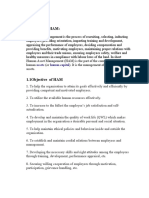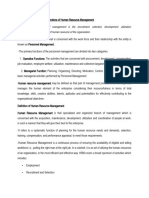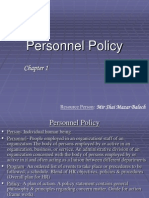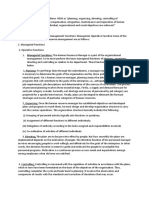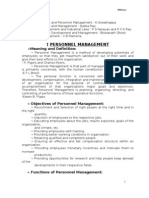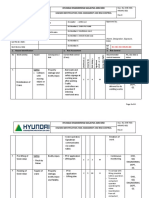Staffing
Staffing
Uploaded by
ngarcia2210952Copyright:
Available Formats
Staffing
Staffing
Uploaded by
ngarcia2210952Copyright
Available Formats
Share this document
Did you find this document useful?
Is this content inappropriate?
Copyright:
Available Formats
Staffing
Staffing
Uploaded by
ngarcia2210952Copyright:
Available Formats
Lesson 3
Staffing: Basic Principles, Structure, and Processes
Introduction
Recruiting the 'best and brightest' has always been one of the major concerns of the government,
whether national or local, when it comes to personnel administration. However, this has been
tempered with the privilege given to a few officials in the government who may appoint
confidential and selected employees without the need of undergoing the usual processes of
recruitment and selection. This is the focus of attention of this lesson.
THE NARRATIVE
What is staffing?
- Staffing is the process of filling positions/posts in the organization with adequate and
qualified personnel.
- Staffing is the process of acquiring, deploying and retaining a workforce of sufficient
quantity and quality to create positive impacts on the organization's effectiveness.
Nature of Staffing
1. Staffing is an important managerial function.
- Manpower is needed in the daily operations of the organization.
2. It is a pervasive activity.
- It is carried out by all managers in all types of concerns.
3. It is a continuous activity.
- It continuous throughout the life of an organization.
4. The basis of staffing function is efficient management of personnel. It aims to
recruit, select, place, train and develop the personnel.
Main Objective of Staffing
“To make sure that people are available at the right time and at the right place”
External Factors affecting Staffing
1. NATURE OF RIVALRY FOR HUMAN RESOURCES
The ratio of unskilled workers versus highly qualified people the imbalance can lead to a change
in staffing policy (e.g. the companies will prefer less talented people if there are more unskilled
workers than highly qualified people)
2. LEGAL FACTORS
: Child labour is prohibited.
Are there reservations for physically handicapped people, the unmarried single-mom or single-
dad?
3. SOCIO-CULTURAL FACTORS
Employment of women for job involving physical exertion is usually avoided.
4. EXTERNAL INFLUENCES
Employers have to face pressures from political parties or politicians as new recruitment.
Internal Factors affecting Staffing
1. ORGANIZATIONAL IMAGE
2. PAST PRACTICES
3. SIZE OF THE ORGANIZATION
4. ORGANIZATIONAL BUSINESS PLAN
Importance of Staffing Function
1. Build an effective human resource
2. Optimize the use of resources select the best candidate
3. Recruit and 4. Train and development of employees
4. Enhance corporate image
5. Enhance Job satisfaction of employees
Who takes charge of Staffing?
THE HUMAN RESOURCE OFFICE (HRO)
THE HUMAN RESOURCE MANAGEMENT OFFICE (HRMO)
THE HUMAN RESOURCE DEPARTMENT (HRD)
THE HUMAN RESOURCE UNIT (HRU)
Steps in Staffing
Step #1 - Human Resource Planning
Definition: Human resource planning is a process that identifies current and future human
resources needs for an organization to achieve its goals.
Step #2A - Recruitment
Edwin Flippo: “Recruitment is the process of searching for prospective employees and
stimulated them to apply for jobs in the organization.”
PROCESS of LOCATING, IDENTIFYING AND ATTRACTING CAPABLE
CANDIDATES
PROCESS that estimates the AVAILABLE VACANCIES in the organization and make
ARRAGMENTS for their selection and appointment.
A POSITIVE FUNCTION in which publicity is given to the jobs available in the organization
and interested candidates are encouraged to submit applications for the selection
OUTPUT: A POOL of eligible and interested candidates is created for the selection of the most
suitable candidates
Why do we recruit?
1. TO FILL OUT VACANCIES due to promotions, transfers, retirement, termination,
permanent disability, death and labor turnover
2. TO CREATE NEW VACANCIES due to growth, expansion and diversification of business
activities of an enterprise.
Step #28 - Selection
Definition: A SERIES OF STEPS from initial applicant screening to the final
hiring of the new employees
1. Completing application materials.
2. Conducting an interview
3. Completing any necessary tests.
4. Doing a background investigation.
5. Socialization
6. Deciding to hire or not to hire
Step #3 - Training
Nehru: “Training is expensive. Without training it is more expensive”
Methods of Training
1. Job rotation workers rotate through a variety of jobs
2. Apprentice training - worker enters the skilled trades is given systematic instruction and
experience both on and off the job in the practical and theoretical aspects of the work
3. Mentoring - A mentor helps a mentee to find the right direction and who can help them to
develop solutions to career issues
4. Internship Programs jointly sponsored by colleges, universities and other organizations
that offer students the opportunity to gain real-life experience
5. Lectures
6. Audiovisual Material
7. Conferences
8. Coaching a corrective method for inadequate performance
Step #4 - Performance Appraisal
Definition:
- A systematic method by which the job performance of an employee is documented and
evaluated.
- A systematic evaluation of the performance of employees and to understand the abilities
of a person for further growth and development.
Who performs appraisal?
Immediate Supervisor
Higher Management
Self-Appraisals Peers (Co-Workers)
Evaluation Teams
Customers "360" Appraisals"
Types of Performance Appraisal
1. SUPERVISOR APPRAISAL - Performance appraisal done by an employee's manager and
often reviewed by a manager one level higher.
2. SELF-APPRAISAL - Performance appraisal done by the employee being evaluated,
generally on an appraisal form completed by the employee prior to the performance review.
3. SUBORDINATE APPRAISAL - It is done by the superior by an employee, which is more
appropriate for developmental than for administrative purposes.
4. PEER APPRAISAL - It is done by one's fellow employees, that are compiled into a single
profile for use in the performance interview conducted by the employee's manager.
5. TEAM APPRAISAL - Performance appraisal, based on TQM concepts, that recognizes team
accomplishment rather than individual performance.
Step #5 - Compensation
Definition: Money and other benefits received by providing services It includes direct cash
payments and indirect payments (employee benefits) and incentives to motivate employees to
strive for higher levels of productivity.
What factors determine pay?
1. EMPLOYER CONSIDERATIONS
2. WHAT JOB DUTIES WILL BE PERFORMED JOB DESCRIPTION & JOB
CLASSIFICATION
3. COMPENSATION STRUCTURE NATIONAL STANDARDIZATION LAW
What is Personnel Administration?
Personnel admnistration generally refers to the act of managing several individuals in an
organization from selection and recruitment to deminissal and retirement processes. Others
define it as follows:
1. It is concerned with the totality of human resources in an organization. It aims to to
qualify the right man for the right job in order to achieve the desired goals and objectives
(Tindero, 2000).
2. It is anything which is related to the human component of any organiztion that involves
the aspect of recruitment, placing. supervision, and management of people within the
organization (Gladwin, 2009).
3. It is the planning, organizing, directing, development, compensation, intergration,
organiztional, and separation of human resources to the end that individual,
organizational, and societal objectivees are attained (Flippo, 2011).
4. It is concerned with human resource of the organization that includes the function of
employment, development, and compesation of the personnel in the organization (Brech,
2009).
Civil Service System in the Phillippines
The term 'civil service' refers generally to the organized group of people that perform several
functions in the nature of public service. These group of individuals covers all those who are
employed in the several branches, subdivisions, instrumentalities, and agencies of the Philippine
govenrment, including government owned and controlled corporations with orgiinal charters and
the local government units provinces, cities, municipalities, and barangays.
The positions of employees in all of these government agencies and instrumentalities are
categoriezed either as career or non-career. Under the existing policies of the Civil Service
Commission (CSC), the individuals in the career positions, who were admitted on the basis of
merit and fitness, enjoy the security of tenure in the posiitons as well as with the opportunities
for advancement in higher positions. On the other hand, the individuals in the non-career service
are also admitted on the basis of merit and fitness with some modifications to suit the conditions
of being non-careers.
In the course of serving the general public, the netire government system expects a lot from the
trusted inviduals and employees who work in the government bureaucracy. Public officials and
employees are expected to uphold and defend the Constitution and the other laws of the
government. They must remain accountable to the people and serve them with utmost
responsibility, integrity, loyalty, efficiency, and act with patriotism and Justice, and lead modest
lives at all times.
The Civil Service Commission
The Civil Service Comission (CSC) in accordance with the Philippine Constitution of 1987 is
considered as the central personnel agency that is mandated to oversee the entire government
bureaucracy. The Commission enjoyes a wide breadth of powers and functions that extends over
the entire administrative system of the country.
Moreover, the CSC just like the other commissions like the Commission on Audit (COA) and
Commission on Elections (COMELEC) was also created as a neutral body in all issues that
personnel matters. It is composed of a chairman and two other commissioners s mandated by the
1987 Constitution of the Philippines. While the Commission may be independent from the other
branches of the government, its chairman and commissioners are all appointed by the
President of the Philippines subject to the necessary confirmation of the Commission of
Appointments (CA) for a period of seven years. Their incumbency in their respective positions
cannot be interrupted by any movement in the national government even with the changes in the
adminstiralton in the executive department.
Among the important offices in the Commission, the following are the crucial offices: Office of
the Assistant Commissioners, Office of Legal Affairs, Examinations, Recruitment, and
Placement Office, Human Resource Development Office, Civil Service Institute, Public
Assistance and Information Office, Office of Planning and Administration, and offices which
contribute in the better performance of the Civil Service Commission.
The Civil Service and Nation Building
Public personnel administration puts the government in the front line when it comes to pursuing
national development in the country. It assumes that the government of a continuous supply of
qualified workers which are essential in the making of a competent and responsive civil service
system. Without the backing of an efficient and effective civil servants, the government, be it
national or local will continue to linger and grope for development to usher in the country.
You might also like
- HR Audit ChecklistDocument6 pagesHR Audit ChecklistHusnaNo ratings yet
- Personnel AdministrationDocument4 pagesPersonnel Administrationjunz90% (10)
- The Modern HR Handbook: An Easy, Quick, and Handy Human Resource Guide for Any HR Manager or HR ProfessionalFrom EverandThe Modern HR Handbook: An Easy, Quick, and Handy Human Resource Guide for Any HR Manager or HR ProfessionalNo ratings yet
- American Safety Technologies MS-880G DK Gray - Part A GHS 139Document8 pagesAmerican Safety Technologies MS-880G DK Gray - Part A GHS 139Muhammad Asyraf Abd HarisNo ratings yet
- Engineering Management: StaffingDocument30 pagesEngineering Management: StaffingJoyce Jardeleza - Estilo100% (2)
- Msds Silicona Roja 65010 VersachemDocument8 pagesMsds Silicona Roja 65010 VersachemErik Evans Saravia0% (1)
- Unit2 - BM501Document9 pagesUnit2 - BM501joshiayush2411No ratings yet
- Unit 4 Personnel AdministrationDocument17 pagesUnit 4 Personnel AdministrationRose ChuchaNo ratings yet
- POM Unit 4Document76 pagesPOM Unit 4happy lifeNo ratings yet
- STAFFINGDocument6 pagesSTAFFINGSaloni AgrawalNo ratings yet
- Summer Training Report FrontDocument74 pagesSummer Training Report Frontnishikantsingh647No ratings yet
- HR Management 501 Date: 18-06-21: 2020-3-95-060@std - Ewubd.edu 2020-2-95-015@std - Ewubd.eduDocument12 pagesHR Management 501 Date: 18-06-21: 2020-3-95-060@std - Ewubd.edu 2020-2-95-015@std - Ewubd.edubonyNo ratings yet
- Selection & StaffingDocument18 pagesSelection & StaffingKaniz NishaNo ratings yet
- HUMAN RESOURSE MANAGEMENT POWEPOINT Presentation24Document13 pagesHUMAN RESOURSE MANAGEMENT POWEPOINT Presentation24kenlay makanaNo ratings yet
- Human Resource Management-An OverviewDocument45 pagesHuman Resource Management-An OverviewAbhishek TewariNo ratings yet
- MS UNIT4 UPDATED R20Document21 pagesMS UNIT4 UPDATED R20Vamsidharreddy KadapanaNo ratings yet
- Chapter 6 - STAFFING - MasterDocument20 pagesChapter 6 - STAFFING - MasterYoshitha SNo ratings yet
- Training and PerformanceDocument80 pagesTraining and PerformancePriyanka PeterNo ratings yet
- (Anuran Bordoloi) Solved Question Bank - HRMDocument112 pages(Anuran Bordoloi) Solved Question Bank - HRMAnuran BordoloiNo ratings yet
- HRM Unit 1Document12 pagesHRM Unit 1NITESH ROHADANo ratings yet
- Personnel Management & Production ManagementDocument136 pagesPersonnel Management & Production ManagementEr Manak Chand SainiNo ratings yet
- Unit 1 Human Resource ManageementDocument27 pagesUnit 1 Human Resource ManageementDeepa PatelNo ratings yet
- Notes On HAM-1Document87 pagesNotes On HAM-1Cletus PaulNo ratings yet
- Human Resource ManagementDocument19 pagesHuman Resource ManagementChandraveer RathoreNo ratings yet
- Unit-8 Staffing Staffing Function of Management: Staffing Process - Steps Involved in StaffingDocument9 pagesUnit-8 Staffing Staffing Function of Management: Staffing Process - Steps Involved in StaffingAkashNo ratings yet
- Personnel Administration in The PhilippinesDocument6 pagesPersonnel Administration in The PhilippinesMalieha Abas KusainNo ratings yet
- Business Management AssignmentDocument34 pagesBusiness Management Assignmentmichaelsd750% (2)
- (Anuran Bordoloi) Solved Question Bank - HRM PDFDocument111 pages(Anuran Bordoloi) Solved Question Bank - HRM PDFAnuran BordoloiNo ratings yet
- $RELSWGMDocument7 pages$RELSWGMjacoub.atccoNo ratings yet
- Notes On HAMDocument89 pagesNotes On HAMCletus Paul100% (1)
- CH 4Document6 pagesCH 4Ebsa AdemeNo ratings yet
- Uniiue, MhgtawoiiDocument14 pagesUniiue, Mhgtawoiiakashdj238No ratings yet
- HRM-II With Question & Answer Bank MBADocument35 pagesHRM-II With Question & Answer Bank MBAVijay SinghNo ratings yet
- Human ResourceDocument19 pagesHuman ResourceErick IsabokeNo ratings yet
- Unit 5 Functions of ManagementDocument38 pagesUnit 5 Functions of Managementskaspate599No ratings yet
- Functions Human Resource Management Functions: Managerial, Operative and Advisory FunctionDocument4 pagesFunctions Human Resource Management Functions: Managerial, Operative and Advisory FunctionGAYATHRI HARIKUMARNo ratings yet
- (DMBA112) Human Resource ManagementDocument9 pages(DMBA112) Human Resource Managementrhisavmukherjee21No ratings yet
- Topic 1-Nature, Scope and Functions of HRMDocument6 pagesTopic 1-Nature, Scope and Functions of HRMarrowphoto10943438andrewNo ratings yet
- Boom Boom MidtermDocument3 pagesBoom Boom Midtermizrah romatanNo ratings yet
- Human Resource ManagementDocument34 pagesHuman Resource Managementhitesh sharmaNo ratings yet
- StaffingDocument4 pagesStaffingshawnratulNo ratings yet
- Personnel Policy: Mir Shai Mazar BalochDocument27 pagesPersonnel Policy: Mir Shai Mazar BalochTariq BezinjoNo ratings yet
- DEFINITION: Edwin Flippo defines-HRM As "Planning, Organizing, Directing, Controlling ofDocument25 pagesDEFINITION: Edwin Flippo defines-HRM As "Planning, Organizing, Directing, Controlling ofJammigumpula Priyanka50% (2)
- Principle and Practice of ManagementDocument30 pagesPrinciple and Practice of ManagementRATHEESH P.KNo ratings yet
- Unit 1-HRMDocument19 pagesUnit 1-HRMShivam PalNo ratings yet
- Chapter 5Document7 pagesChapter 5dennis tanNo ratings yet
- #6 StaffingDocument25 pages#6 StaffingJoanna Garcia100% (1)
- MS Unit 4Document24 pagesMS Unit 4Sanjana DasNo ratings yet
- Vidya ProjectDocument100 pagesVidya ProjectchavvakulavidyasriNo ratings yet
- Chapter Five 2022Document11 pagesChapter Five 2022abdiimohammedadamNo ratings yet
- Induction, Deployment, Retaining, PromotionDocument40 pagesInduction, Deployment, Retaining, PromotionAyang TayengNo ratings yet
- Unit 1: Human Resource Management: ScopeDocument3 pagesUnit 1: Human Resource Management: ScopeAnonymous ldN95iANo ratings yet
- Human Resource Management Functions: Its Objectives AreDocument4 pagesHuman Resource Management Functions: Its Objectives ArePejwal MohitNo ratings yet
- Concept and Nature of Staffing - Week 2Document19 pagesConcept and Nature of Staffing - Week 2Jessica Saludar OmbosNo ratings yet
- Management FunctionsDocument18 pagesManagement FunctionsVipinVincentNo ratings yet
- HRM Notes For MHRDM 3Document65 pagesHRM Notes For MHRDM 3Jeeta Sarkar100% (3)
- RandS Module1Document6 pagesRandS Module1Lingahan EricaNo ratings yet
- Definition of Staffing and Steps inDocument10 pagesDefinition of Staffing and Steps inEfean KimNo ratings yet
- BDPB2103-Topik 1Document16 pagesBDPB2103-Topik 1Frizal Rahim100% (1)
- Enhancing Success for Performance Management in the Public SectorFrom EverandEnhancing Success for Performance Management in the Public SectorNo ratings yet
- Examining Career Development within Learning Organisations: Career Development Book Series, #4From EverandExamining Career Development within Learning Organisations: Career Development Book Series, #4No ratings yet
- Public Sector Competency-Based Development and Self-Assessment Handbook: A Self Assessment Handbook for Public Servants, Their Supervisors and TrainersFrom EverandPublic Sector Competency-Based Development and Self-Assessment Handbook: A Self Assessment Handbook for Public Servants, Their Supervisors and TrainersNo ratings yet
- SHRM RecruitmentDocument10 pagesSHRM RecruitmentPREJA PATELNo ratings yet
- Jsa CompoundDocument4 pagesJsa CompoundRavi thokalNo ratings yet
- Human Resource Management: Chapter 2: The Analysis and Design of WorkDocument5 pagesHuman Resource Management: Chapter 2: The Analysis and Design of WorkEricka Razon ContanteNo ratings yet
- Letter For Mobile PhoneDocument1 pageLetter For Mobile PhoneDasari Venkatesh100% (1)
- Hirarc Form - SampleDocument11 pagesHirarc Form - SampleMohd Azro Mohd NorNo ratings yet
- Rebar Lifting Jha 001Document4 pagesRebar Lifting Jha 001Justin JuniorNo ratings yet
- Safety Data Sheet: 1. Product and Company IdentificationDocument8 pagesSafety Data Sheet: 1. Product and Company IdentificationErick FaundezNo ratings yet
- Ijm Corporation Berhad: Hazard Identification and Risk Assessment AnalysisDocument2 pagesIjm Corporation Berhad: Hazard Identification and Risk Assessment Analysishaidil abd hamidNo ratings yet
- LAS IN DRESSMAKING 7-8 Week 7Document3 pagesLAS IN DRESSMAKING 7-8 Week 7Lorily B. Abad100% (3)
- 4 Jsa Jha Ra CoshDocument113 pages4 Jsa Jha Ra CoshEunice Gayeta100% (2)
- Safety Data Sheet: Section 1: Identification of The Substance/Mixture and of The Company/UndertakingDocument12 pagesSafety Data Sheet: Section 1: Identification of The Substance/Mixture and of The Company/UndertakingELYES CHOUCHENENo ratings yet
- Group 3 Industrial HygieneDocument20 pagesGroup 3 Industrial HygieneMary Adela Dela CruzNo ratings yet
- Leyland Trade Satinwood COSHH Assessment Form 2024Document3 pagesLeyland Trade Satinwood COSHH Assessment Form 2024paulsawleyNo ratings yet
- LacquerDocument5 pagesLacquerABOSEDE BLESSINGNo ratings yet
- NEOM OPERATIONS - FM - Genaral PTWDocument3 pagesNEOM OPERATIONS - FM - Genaral PTWHBHJBMN100% (2)
- Chapter 3 - OSHE AccidentDocument28 pagesChapter 3 - OSHE Accident2023131173No ratings yet
- Dry Rework and Wet Rework OkDocument3 pagesDry Rework and Wet Rework OkRinaldyNo ratings yet
- Potensi Bahaya Fisika, Kimia, Biologi, Ergonomi, Dan Psikologi Pada Tenaga Kerja Di Area Produksi Pabrik GulaDocument5 pagesPotensi Bahaya Fisika, Kimia, Biologi, Ergonomi, Dan Psikologi Pada Tenaga Kerja Di Area Produksi Pabrik GulaPUSPANo ratings yet
- DTR FormDocument1 pageDTR FormSharlene Mae DeJesus AbreraNo ratings yet
- Hira Electrical WorkDocument11 pagesHira Electrical Workshubhambhardwaj8583No ratings yet
- BLUEPRINT - Basic Principles of Toxicology Elective TYDocument2 pagesBLUEPRINT - Basic Principles of Toxicology Elective TYDAMBALENo ratings yet
- 30 Hour Construction Industry Outreach Study Guide - 2021Document474 pages30 Hour Construction Industry Outreach Study Guide - 2021Angel BlackmoreNo ratings yet
- dbt282 IndividuDocument18 pagesdbt282 Individuhaiqalhaziq69No ratings yet
- Section 5 Health SafetyDocument6 pagesSection 5 Health SafetyArbaz AhmedNo ratings yet
- 01 - CoCU 01 Workshop PractisesDocument14 pages01 - CoCU 01 Workshop PractisesBatangan JamboreeNo ratings yet
- Maintenance of EmployeesDocument13 pagesMaintenance of EmployeesRhea Joy L. SevillaNo ratings yet
- LFI May-009 vfDocument1 pageLFI May-009 vfVishnu MuraleedharanNo ratings yet






















